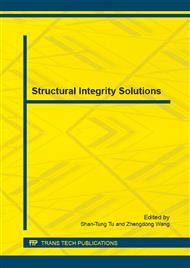[1]
J. Brózda, New generation creep-resistant steels, their weldability and properties of welded joints: T/P92 steel. Welding International, 19 (2005) 5-13.
DOI: 10.1533/wint.2005.3370
Google Scholar
[2]
W. Prager, A new method of analyzing stresses and strains in work hardening plastic solids. ASME, Journal of Applied Mechanics, 78 (1956) 493-496.
DOI: 10.1115/1.4011389
Google Scholar
[3]
Z. Mroz, On the description of anisotropic work hardening. Journal of the Mechanics and Physics of Solids, 15 (1967) 163-175.
Google Scholar
[4]
P. J. Armstrong, C. O. Frederick, A mathematical representation of the multiaxial Bauschinger effect. CEGB Report RD/B/N/731, Berkeley Nuclear Laboratories, R&D Department, CA, (1966).
Google Scholar
[5]
J. L. Chaboche, Time-independent constitutive theories for cyclic plasticity. International Journal of Plasticity, 2 (1986) 149-188.
DOI: 10.1016/0749-6419(86)90010-0
Google Scholar
[6]
N. Ohno, J. D. Wang, Kinematic hardening rules with critical state of dynamic recovery, Part II: Application to experiments of ratchetting behavior. International Journal of Plasticity, 9 (1993) 391-403.
DOI: 10.1016/0749-6419(93)90043-p
Google Scholar
[7]
A. Dutta, S. Dhar, S. K. Acharyya, Material characterization of SS 316 in low-cycle fatigue loading. Journal of Materials Science, 45 (2010) 1782-1789.
DOI: 10.1007/s10853-009-4155-7
Google Scholar
[8]
Z. L. Zhan, J. Tong, A study of cyclic plasticity and viscoplasticity in a new nickel-based superalloy using unified constitutive equations. Part II: Simulation of cyclic stress relaxation. Mechanics of Materials, 39 (2007) 73-80.
DOI: 10.1016/j.mechmat.2006.01.006
Google Scholar
[9]
C. J. Hyde, W. Sun, T. H. Hyde, et al, Thermo- mechanical fatigue testing and simulation using a viscoplasticity model for a P91 steel. Computational Materials Science, 56 (2012) 29-33.
DOI: 10.1016/j.commatsci.2012.01.006
Google Scholar
[10]
A. A. Saad, W. Sun, T. H. Hyde, et al, Cyclic softening behaviour of a P91 steel under low cycle fatigue at high temperature. Procedia Engineering, 10 (2011) 1103-1108.
DOI: 10.1016/j.proeng.2011.04.182
Google Scholar
[11]
Y. P. Gong, C. J. Hyde, W. Sun, et al, Determination of material properties in the Chaboche unified viscoplasticity model. Proceedings of the Institution of Mechanical Engineers, Part L: Journal of Materials Design and Applications, 224 (2010).
DOI: 10.1243/14644207jmda273
Google Scholar
[12]
A. A. Saad, Cyclic plasticity and creep of power plant materials. University of Nottingham, (2012).
Google Scholar
[13]
G. Kang, A visco-plastic constitutive model for ratcheting of cyclically stable materials and its finite element implementation. Mechanics of Materials, 36 (2004) 299-312.
DOI: 10.1016/s0167-6636(03)00024-3
Google Scholar
[14]
M. Kobayashi, N. Ohno, Implementation of cyclic plasticity models based on a general form of kinematic hardening. International Journal for Numerical Methods in Engineering, 53 (2002) 2217-2238.
DOI: 10.1002/nme.384
Google Scholar


